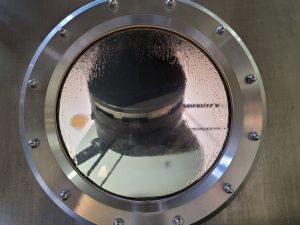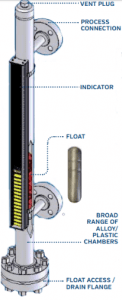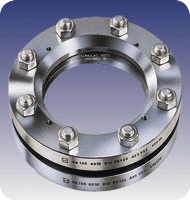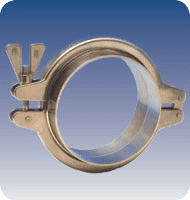The adage about a picture being worth a thousand words translates more pragmatically into worth measured in dollars in industries that requires or benefit from process observation and analysis. A ruined process or a wasted batch costs companies money and wastes time, while observation can help prevent such occurrences.
A sight glass observation port provides a view into the interior of the process vessel or tank. It supplies numerous benefits to monitor the vessel’s contents and processes, such as ensuring chemical reactions occur at the appropriate time, that liquid or fluid levels are maintained or that cleaning processes are conducted properly, as a few examples.
While a sight glass window or observation port provides safer, more effective monitoring, a camera mounted to the window can increase worker safety, improve process efficiencies and help diagnose problems in high pressure operations.
Some companies are slow to add a camera to their process, citing concerns about high costs, maintenance time or system complexity. However, customers who in the past might have investigated cameras as a customized option for an observation window will find that camera technology has advanced, and prices have dropped. Installation no longer requires extensive wiring or drastic changes to infrastructure. The camera now exists as part of the process observation equipment package. The dramatic price differences and ease of installation and use make it a more practical consideration today than within the past few years.
Safety concerns the major driver for cameras
Safety concerns are the main driver for camera installations as part of sight glass observation ports. Many process vessels or tanks pose safety risks due to height, location, or difficult access points. Companies trying to reduce injuries and accidents within the plant install cameras on sight glass windows to enable remote observation rather than regularly having workers climb to the top of the process tank. While cameras replace the necessity of a physical check or observation, they provide much more than a mechanical pair of eyes.
Improve batch consistency and improve product quality
The camera live streams the entire process, not just a portion or brief snapshot like a physical glance inside the tank. This live stream allows for real time observation of one or more tanks simultaneously. This, combined with data capture, helps operators more easily analyze processes and diagnose problems or prevent product inconsistencies.
For example, a major brewing company was producing batches with an off flavor, despite ingredients and processes remaining consistent. A video camera installed on the sight glass window enabled the company to discover that due to an equipment malfunction, materials related to the clean in place (CIP) processes were not completely flushing out of the system after a cleaning cycle. As a result, residual materials were contaminating new products being brewed in the vessels. The camera system enabled the company to examine the full production and CIP processes to find and fix the problem.
Remote access through POE eliminates COAX
Power over Ethernet (PoE) has revolutionized the reach and reduced the complexity and expense of installing cameras on process vessel sight glass windows. Formerly, cameras required yards upon yards of coaxial cable. Often tanks were located outside the range of coaxial cable installation, or the distance made cable installation cost prohibitive. In some cases, the cable and its installation could cost many times more than the amount of the camera itself.
Today’s camera systems require a much shorter cable length, just far enough to reach a network device. The power over ethernet allows the camera to stream from any location. This substantially reduces the cost and makes installation much more manageable. In addition, remote capabilities enable streaming into a control room, onto a tablet or even a cell phone, for greater employee safety and greater and more instantaneous process control.
Process observation cameras for hygienic or combustible/hazardous conditions
Cameras are available for hazardous or potentially combustible areas, while others meet standards for sanitary applications in the food and beverage or pharmaceutical space. An “explosion-proof” designation means that the wiring and design will not cause or contribute to an explosion within the set atmosphere. These cameras meet UL standards for North America and those established by agencies in other countries. The cameras are rated according to zones that correlate to the combustion potential of processed materials.
Cameras rated for hygienic conditions can combine sanitation protocols with hazard protection.
This comes in handy in the food industry, for example, with spray drying. Spray drying converts liquids or slurries into fine, dry powders. Although mounted on the outside of the process vessel, spray drying involves high heat and the heat does impact instrumentation and accessories located outside of the tank. Cameras are cooled using either air or water to help avoid overheating.
Industries that rely on spray dryers include chemicals, pharmaceuticals, nutraceuticals, the dairy industry and food processing for protein powders, mixes, encapsulated flavors and more. However, a common problem during spray drying is a buildup of materials on and around the nozzle, which can cause a clog or breakdown. In one instance, a customer spray-drying whey protein powders wanted to install a camera on the sight glass observation window to view the spray nozzles. Unfortunately, they were experiencing malfunctioning equipment. An explosion proof rated camera helped provide the information the client needed to identify and solve the problem, preventing process interruptions.
One challenge with explosion-proof cameras involves lighting in a highly reflective environment. Not only does the camera company work to minimize reflectivity to achieve sharper images from within the process vessel, combining lighting with video expertise, but the sight glass also offers more lighting to improve the view. LJ Star’s LED Luminaire Series 55-EX, the first high-power LED sight glass light with an explosion-proof rating, is available with six LEDs instead of three.
A full package with service options
Companies that work with LJ Star will find that the cameras used for observation are half the cost they were a few years ago. The PoE cuts down drastically on the amount of coaxial cable required and simplifies and expands installation potential. LJ Star includes a warranty that covers sight glass components such as cameras. Companies having technical issues can call 24/7 for support.
Camera accessories can include recording devices, or a computer programmed with the software to run the camera. This makes it easier for smaller companies with fewer resources and available systems to use the camera feature for their observation ports. A full solution is available from LJ Star.
LJ Star cameras are built to withstand the challenging environmental conditions inside an industrial processing plant, such as temperature, dust, moisture or vibration. As companies strive to free up employees from fixed positions on the plant floor for more nimble operations, a process observation camera helps make it possible for companies to leverage existing staff while achieving higher quality standards.
Find further details about the options available for process vessel cameras and mounting from LJ Star for remote observation of the interior of your tank, vessel or reactor.




